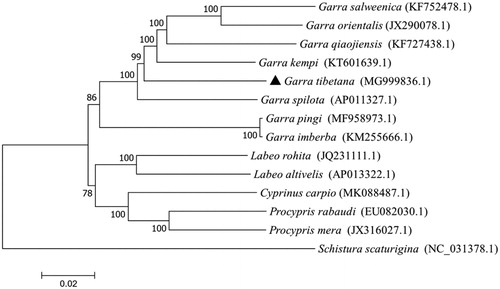Abstract
The Garra tibetana, an important economic fish belonging to the genus Garra, family Cyprinidae, is mainly distributed in Tibet with rare biological resources. Here, we sequenced and characterized the complete mitochondrial genome of G. tibetana for the first time, and the results showed that the total length of G. tibetana mitogenome was 16,861 bp, consisting of 13 protein-coding genes, 2 rRNA genes, 22 tRNA genes, and 2 control regions. Unlike the typical mitochondrial genome organization in vertebrate, the D-loop region was separated into two part by a tRNAPro gene. To further explore the phylogenetic relationship of the G. tibetana, we constructed the phylogenetic tree and verified that the G. tibetana was a new species of the genus Garra and had a closer relationship with Garra kempi. This study not only provided valuable evidence on phylogenetic relationship of the G. tibetana at the molecular level, but also provided an essential resource for further population genetics research and germplasm conservation on this species.
The genus Garra Hamilton 1822 is a group of freshwater fishes, which are of great economic value and widely distributed in southern Asia and northeast Africa. At present, 20 different species of Garra have been recognized from the Brahmaputra River basin, of which there are four species in China, namely, Garra tibetana, G. dengba, G. motuoensis, G. yajiangensis (Deng et al. Citation2018; Gong, Freyhof et al. Citation2018; Gong, Deng et al. Citation2018). These species mainly inhabited in the rocky or turbulent rivers, and its food includes phytodetritus in open water habitats, as well as periphyton in substrate-surface habitats (Nebeshwar et al. Citation2009). Since G. tibetana and Garra kempi Hora 1921 have many similarities in morphological characterization, G. tibetana was misidentified as G. kempi for a long period. In recent years, the mitogenome is widely used in the study of population genetics and molecular phylogenetics due to its high substitution rate, non-recombination and nature of maternal inheritance (Galtier et al. Citation2009). However, so far, there were only six reports about the complete mitochondrial genome of Garra and their corresponding molecular evolutions are still limited. Therefore, the complete mitogenome of G. tibetana is reported here, which could provide important genomic information for the studies of the evolution relationship and population genetics of genus Garra.
Twenty-six fish specimens were collected from lower reach of Brahmaputra River (95°16′56″N, 29°17′52.8″E) in Tibet, China. All voucher specimens were deposited at the Museum of Aquatic Organisms at the Institute of Fisheries Science, Tibet Academy of Agricultural and Animal Husbandry Sciences, Tibet, China. In this study we used the specimen with accession number: 20190006JK. The neighbor-joining (NJ) tree of the G. tibetana was constructed using Mega7.0 (Kumar et al. Citation2016).
The mitogenome of G. tibetana was completely sequenced, and our findings revealed that the circular genome was 16,861 bp (GenBank MG999836.1). The whole mitochondrial genome consisted of 13 protein-coding genes, 22 tRNA genes, 2 rRNA genes (12S and 16S rRNA), and 2 control regions (D-loop and OL). Base frequency of the whole mtDNA region was A = 32.3%, T = 26.1%, C = 26.2%, and G = 15.4%, with a relatively lower level of G and a slight A + T bias of 58.4%. The 13 mRNAs contained three start codons, two termination codons, and six overlap regions. The 22 tRNA scattered among the whole mitochondrion, and they were in the range from 68 (tRNAPhe) to 76 (tRNALys and tRNALeu) in length (table1). The D-loop was 1199 bp in length and separated into two parts by a tRNAPro gene, which is very similar to G. kempi mitochondrial genome (Li et al. Citation2016).
To further explore the phylogenetic and taxonomic status of G. tibetana, a neighbor-joining tree was constructed with 13 species from four genus. Phylogenetic analyses verified that the G. tibetana is a member of the genus Garra and has a much closer relationship with G. kempi compared to other species of Garra (Garra spilota, Garra qiaojiensis, Garra rufa, Garra orientalis, and Garra flavatra) ().
Figure 1. A neighbor-joining (NJ) tree of the G. tibetana. The phylogenetic tree was inferred from the nucleotide sequences of 14 mitogenome using ML methods. Schistura scaturigina was selected as an outgroup.

Our findings provided valuable evidence on phylogenetic relationship of the G. tibetana at the molecular level. Moreover, the compete mitogenome of G. tibetana could provide an effective tool for population genetics and evolutionary biology study, as well as the germplasm resources conservation related to this species.
Disclosure statement
No potential conflict of interest was reported by the author(s).
Additional information
Funding
References
- Deng SQ, Cao L, Zhang E. 2018. Garra dengba, a new species of cyprinid fish (Pisces: Teleostei) from eastern Tibet, China. Zootaxa. 4476(1):94–108.
- Galtier N, Nabholz B, Glémin S, Hurst GDD. 2009. Mitochondrial DNA as a marker of molecular diversity: a reappraisal. Mol Ecol. 18(22):4541–4550.
- Gong Z, Deng SQ, Wang J, Hz L. 2018. A new species of genus Garra (Cypriniformes: Cyprinidae) from the lower Yarlung Tsangpo river rainage in southeastern Tibet, China. Chin J Zool. 53:857–867. In Chinese with English abstract.
- Gong Z, Freyhof J, Wang J, Liu M, Liu F, Lin PC, Jiang YL, Liu HZ. 2018. Two new species of Garra (Cypriniformes: Cyprinidae) from the lower Yarlung Tsangpo river drainage in southeastern Tibet, China. Zootaxa. 4532(3):367–384.
- Kumar S, Stecher G, Tamura K. 2016. MEGA7: molecular evolutionary genetics analysis version 7.0 for bigger datasets. Mol Biol Evol. 33(7):1870–1874.
- Li H, Liu Y, Cao HZ, Chen YY, Du J. 2016. The complete mitochondrial genome of Garra kempi (Teleostei, Cyprinidae, Garra). Mitochondrial DNA Part A. 27(6):4631–4632.
- Nebeshwar K, Vishwanath V, Das DN. 2009. Garra arupi, a new cyprinid fish species (Cypriniformes: Cyprinidae) from upper Brahmaputra basin in Arunachal Pradesh. J Threat Taxa. 1(4):197–202.
